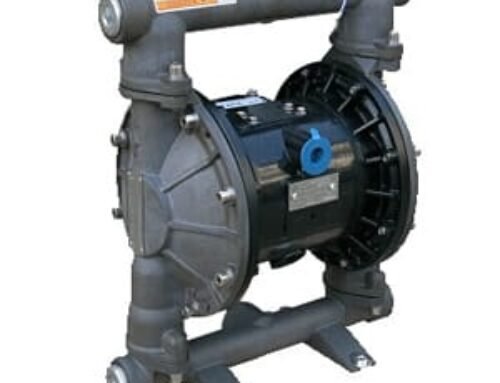Pumps are critical components in fluid transfer and dosing systems across industries. Two of the most widely used types are the centrifugal pump vs diaphragm pump.
Both serve the same purpose which is to move liquids, but they differ in design, working principle, and performance characteristics. Understanding these differences is essential for selecting the right pump for your operation, whether in water treatment, chemical processing, or industrial manufacturing.
Below is a detailed explanation of how these two pump types work and what separates one from the other.
1. Working Principle
The first and most fundamental difference lies in how each pump moves liquid.
A centrifugal pump uses a high-speed rotating impeller to impart kinetic energy to the fluid. As the impeller spins, the liquid is flung outward toward the discharge port by centrifugal force. The velocity energy is then converted into pressure, allowing the fluid to flow continuously through the system. This design works best for large volumes of liquid that need to be transferred quickly and smoothly.
In contrast, a diaphragm pump operates on a reciprocating principle. It uses a flexible diaphragm that moves back and forth inside a sealed chamber. When the diaphragm retracts, it creates suction, drawing fluid into the chamber. When it pushes forward, it compresses the fluid and forces it out through an outlet valve. This process repeats continuously, producing a pulsating flow.
Simply put, centrifugal pumps rely on rotational force, while diaphragm pumps rely on mechanical displacement.
2. Flow Characteristics
A centrifugal pump delivers continuous and smooth flow, which makes it ideal for transferring clean liquids at high volumes. The constant rotation of the impeller ensures steady pressure with minimal pulsation, which is beneficial in applications like water circulation, cooling systems, and irrigation.
A diaphragm pump, on the other hand, delivers intermittent or pulsating flow. Each diaphragm stroke moves a fixed amount of fluid. Although this pulsation can be reduced with dampeners, it’s an inherent characteristic of diaphragm pumps. However, this design allows for precise control over dosing, which is critical in applications like chemical injection, water treatment, and pharmaceuticals.
If your system prioritizes flow stability and speed, centrifugal pumps excel. If your process requires accuracy and chemical compatibility, diaphragm pumps are superior.
3. Pressure Capability
Centrifugal pumps are optimized for low to medium pressure applications. Typical operating pressures are under 10 bar. They are efficient for moving liquids over short to medium distances or circulating them through systems with minimal resistance.
Diaphragm pumps can handle higher pressure ranges, often reaching up to 20 bar or more, depending on the model. This makes them ideal for metering chemicals into pressurized systems, transferring viscous fluids, or operating in environments with variable resistance.
In short, centrifugal pumps prioritize flow volume, while diaphragm pumps prioritize pressure control.
4. Self-Priming and Suction Performance
Self-priming is another major factor that distinguishes these two types.
A centrifugal pump generally cannot self-prime. It requires the pump casing to be filled with liquid before startup. If operated dry, the impeller may overheat and damage the seals. This limitation makes centrifugal pumps less suitable for suction-lift applications or systems where the fluid source is below pump level.
Conversely, a diaphragm pump is inherently self-priming and can run dry without damage. It can draw liquid from several meters below the pump, making it suitable for remote or variable-level applications such as chemical transfer tanks or wastewater pits.
For installations where suction lift and dry-run safety are essential, the diaphragm pump is the clear choice.
5. Fluid Compatibility and Handling
Fluid type plays a crucial role in selecting a pump.
A centrifugal pump works best with clean, low-viscosity liquids such as water, light oils, or coolants. Solids, slurries, or viscous substances can clog the impeller, reduce efficiency, or cause wear.
A diaphragm pump is far more versatile. It can handle corrosive, viscous, or abrasive fluids, as well as slurries or chemicals containing solid particles. Because the fluid is contained within the diaphragm chamber, there’s no need for dynamic seals, minimizing leakage risks. For hazardous or chemically aggressive fluids, diaphragm pumps provide superior containment and safety.
Thus, centrifugal pumps are suited for clean transfer applications, while diaphragm pumps handle challenging or aggressive fluids.
6. Maintenance and Reliability
Maintenance requirements differ significantly between the two.
Centrifugal pumps have relatively simple construction and low maintenance demands. The primary wear components are the mechanical seals and bearings. However, these seals are vulnerable to dry running and leakage if not maintained properly.
Diaphragm pumps have more internal components—such as valves and diaphragms—that eventually wear out due to flexing. Still, they are easy to service and have no rotating seals, eliminating leakage risk. Diaphragm replacement is straightforward and cost-effective, making them reliable for continuous industrial operation.
In environments where leakage control and chemical compatibility are top priorities, diaphragm pumps offer better long-term reliability.
7. Typical Applications
Because of their structural and operational differences, centrifugal and diaphragm pumps serve distinct industrial roles:
Centrifugal Pump Applications:
- Water supply and distribution systems
- Irrigation and drainage
- Cooling and heating circulation
- General fluid transfer in manufacturing
Diaphragm Pump Applications:
- Chemical dosing and metering
- Wastewater and sludge handling
- Oil and gas chemical injection
- Food and pharmaceutical processing
- Agricultural fertilization systems
The centrifugal pump dominates where high volume and low pressure are needed. The diaphragm pump dominates where controlled dosing, self-priming, or chemical resistance are required.
Conclusion
Both centrifugal and diaphragm pumps are vital in modern fluid handling, but their strengths serve different operational goals.
A centrifugal pump offers smooth, continuous flow and high efficiency for clean liquid transfer at lower pressures. A diaphragm pump provides precise, leak-free, and chemical-resistant operation suitable for high-pressure dosing or challenging fluids.
Choosing between centrifugal pumps vs diaphragm pumps depends on your process requirements flow rate, pressure, fluid type, and environmental safety. Selecting the right pump not only optimizes performance but also reduces maintenance costs and ensures long-term reliability.







Leave A Comment